June 20, 1977 – Oil begins Flowing in Trans-Alaska Pipeline –
The Trans-Alaska Pipeline began carrying oil 800 miles from Prudhoe Bay to the Port of Valdez at Prince William Sound. The oil arrived 38 days later, culminating the world’s largest privately funded construction project at that time. The Prudhoe Bay field had been discovered in 1968 by Atlantic Richfield and Exxon about 250 miles north of the Arctic Circle.
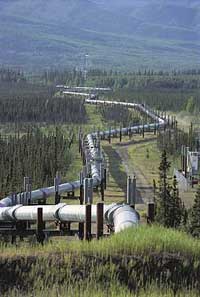
After much controversy, construction of the Trans-Alaska Pipeline began in April 1974. Photo courtesy Alaska Pipeline Authority.
Construction of the 48-inch-wide pipeline began in April 1974. Above-ground sections of the pipeline (420 miles) were built in a zigzag configuration to allow for expansion or contraction with temperature changes. In some permafrost areas the supports include “heat pipes.”
Oil throughput of the $8 billion pipeline peaked in 1988 at just over two million barrels per day, according to the Energy Information Administration (EIA). adding that since 2003, “actual deliveries have been less than one million barrels per day, and averaged 483,000 barrels per day in 2022, the first year-over-year increase since 2017.”
Learn more in Trans-Alaska Pipeline History.
June 21, 1893 – Submersible Pump Inventor born
Armais Arutunoff, inventor of the electric submersible pump for oil wells, was born to Armenian parents in Tiflis, Russia. He would invent the world’s first electrical centrifugal submersible pump in 1916. At first, Arutunoff could not find financial support for his oilfield production technology after emigrating to the United States in 1923.
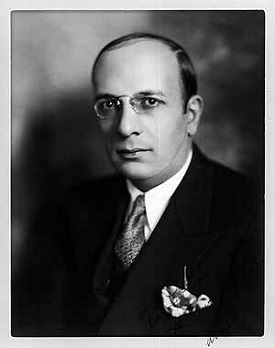
Russian engineer Armais Arutunoff invented of the first electric submersible pumps.
Thanks to help from his friend Frank Phillips, president of Phillips Petroleum, in 1928 Arutunoff moved to Bartlesville, Oklahoma, and established a manufacturing company. His REDA Pump Company manufactured pump and motor devices (and employed hundreds during the Great Depression).
The name REDA, which stands for Russian Electrical Dynamo of Arutunoff, was the cable address of the company he originally formed in Germany (it is now part of Schlumberger).
A 1936 Tulsa World article described his invention as “an electric motor with the proportions of a slim fencepost which stands on its head at the bottom of a well and kicks oil to the surface with its feet.”
Learn more in Inventing the Submersible Pump.
June 21, 1932 – Oklahoma Governor attacts “Hot Oil”
Thirty National Guardsmen marched into the Oklahoma City oilfield when Governor William H. “Alfalfa Bill” Murray took control of oil production after creating a proration board despite objections from independent producers.
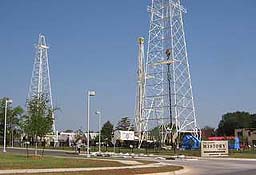
The Oklahoma History Center in Oklahoma City includes petroleum equipment on display in the Devon Energy Park, which opened in 2005. Photo by Bruce Wells.
Murray would declare martial law again in March 1933 to enforce his regulations preventing the sale or transport of oil produced in excess of the quota, referred to as “hot oil.”
The state legislature passed a law in April giving the Oklahoma Corporation Commission authority to enforce its rules — taking away Gov. Murray’s power to regulate the petroleum industry. The commission had been established in 1907 to regulate railroad, telephone, and telegraph companies.
June 23, 1921 – Signal Hill Discovery brings California Oil Boom
Another southern California drilling boom began when a geyser of “black gold” erupted 114 feet high at Signal Hill. The Alamitos No. 1 well, which revealed a giant oilfield, produced about 600 barrels of oil a day when it was completed.
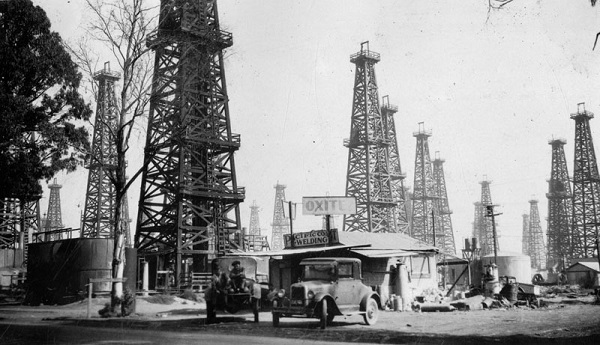
The Signal Hill oil discovery helped make California the source of one-quarter of the world’s entire oil output. “Porcupine Hill” and the Long Beach field produced 260,000 barrels of oil a day by 1923.
Soon known as “Porcupine Hill,” the Signal Hill oilfield 20 miles south of Los Angeles produced almost 260,000 barrels of oil a day by 1923. Combined with the 1892 Los Angeles Oilfield discovery and the 1920 Huntington Beach oilfield, California produced one-fourth of the world’s oil. A monument dedicated in 1952 at Signal Hill’s Discovery Well Park has served “as a tribute to the petroleum pioneers for their success here.”
Learn more in Signal Hill Oil Boom.
June 23, 1947 – Supreme Court limits State Rights to Continental Shelf
The U.S. Supreme Court ruled that California could not claim rights to the continental shelf beyond three nautical miles. Litigation had resulted from President Harry Truman’s 1945 Continental Shelf Proclamation, which placed control with the federal government. The Supreme Court ruling affirmed federal jurisdiction “with respect to the natural resources of the subsoil and seabed of the continental shelf.” Similar rulings affecting Louisiana and Texas would be made in 1950.
June 24, 1937 – Trace of Oil found in Minnesota
A remote wildcat well drilled in Traverse County in the western part of Minnesota began producing three barrels of oil a day from a depth of 864 feet. The unlikely discovery prompted more leasing, but no commercial quantities of oil were found.
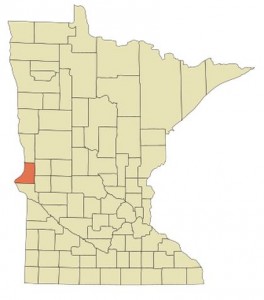
Traverse County, Minnesota, where oil production peaked in 1937.
This reaffirmed geologists’ conclusions since 1889 that the conditions for significant oil deposits did not exist in Minnesota, despite some water wells in southern Minnesota containing small amounts of natural gas. “Not much oil and gas is obtained from Precambrian rocks, with which Minnesota is very amply blessed,” noted Richard Ojakangas in his 1984 book, Minnesota’s Geology.
June 25, 1889 – First Oil Tanker catches Fire in California
The first oil tanker built for that purpose burned at its wharf in Ventura, California. The Hardison & Stewart Oil Company (later Union Oil) had commissioned the schooner W.L. Hardison, an experimental vessel that offered an alternative to paying for railroad oil tank cars charging one dollar per oil barrel to reach markets in San Francisco.
With oil-fired steam boilers and supplemental sails, the schooner could ship up to 6,500 barrels of oil below deck in specially constructed steel tanks. After the fire, the tanks were recovered and used at the company’s Santa Paula refinery. It would take 11 years before the company launched a replacement tanker, the Santa Paula.

Rare photographs of the oil doomed tanker W.L. Hardison and Ventura pier courtesy the Museum of Ventura County.
The Ventura Wharf Company by April 1898 had exported 518,204 barrels of bulk oil during the previous year, according to the Los Angeles Times. The pier remained a working wharf until 1936, when it became the longest recreational wooden pier in California (now reaching 1,958 feet).
Designated a Ventura Historic Landmark in 1976, California’s oldest pier was refurbished for $2.2 million in 2000, according to Museum of Ventura County, whose library collection includes 150,000 county resources. More petroleum history can be found at the California Oil Museum in Santa Paula, with exhibits in the original 1890 headquarters of Union Oil Company.
June 25, 1901 – Red Fork Discovery leads to Tulsa Boom
The future state of Oklahoma witnessed a second oil discovery in 1901 (some say the third — see Another First Oklahoma Oil Well). Four years earlier, the Nellie Johnstone No. 1 well had brought a drilling boom to Bartlesville in Indian Territory. At Red Fork, still six years before statehood, two drillers from Pennsylvania made the new discovery in the Creek Indian Nation.
Drillers John Wick and Jesse Heydrick drilled their Sue A. Bland No. 1 well near the Creek village across the Arkansas River from Tulsa. Sue Bland, a Creek citizen, was the wife of the homestead owner Dr. John C. W. Bland. Their Red Fork well produced just 10 barrels of oil a day from a depth of 550 feet, but it created a drilling boom that attracted petroleum companies to nearby Tulsa.
Learn more in Red Fork Gusher.
June 25, 1999 – Post Office with Oilfield Painting named Historic Place
The former U.S. Post Office in Graham, Texas, with its Great Depression era oilfield mural by Alexandre Hogue, was added to the National Register of Historic Places. Hogue’s Oil Fields of Graham, painted in 1939, had been restored to the lobby of the Art Deco building in 1996.

Oil Fields of Graham by Alexandre Hogue, a 1939 mural restored in 2002 at the Old Post Office Museum & Art Center, in Graham, Texas.
Hogue’s artwork included many southwestern scenes as part of the New Deal Federal Arts Program. His murals on the walls of public buildings often portrayed scenes of the Texas petroleum industry. Oil Field of Graham, 12 feet wide and 7 feet high, today is an exhibit at the Old Post Office Museum & Art Center, which opened in 2002.
Learn more in Oil Art of Graham, Texas.
_______________________
Recommended Reading: The Great Alaska Pipeline (1988); Artificial Lift-down Hole Pumping Systems
(1984); Signal Hill, California, Images of America
(2006); Minnesota’s Geology (1982) Tulsa Oil Capital of the World, Images of America
(2004); Oil in West Texas and New Mexico
(1982). Your Amazon purchase benefits the American Oil & Gas Historical Society. As an Amazon Associate, AOGHS earns a commission from qualifying purchases.
_______________________
The American Oil & Gas Historical Society (AOGHS) preserves U.S. petroleum history. Become an AOGHS annual supporting member and help maintain this energy education website and expand historical research. For more information, contact bawells@aoghs.org. Copyright © 2023. Bruce A. Wells. All rights reserved.


